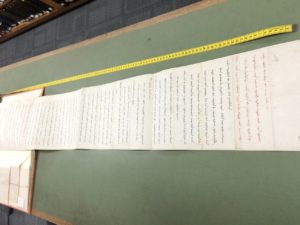I’ve spent the last couple of days working on a section of my dissertation describing and analyzing the famous Brevis Relatio. The story of the text is well known. In 1700, the French Jesuit Louis Le Comte and several others decided to petition the Kangxi emperor for a judicial ruling on rites to the ancestors and Confucius. On November 30, Hesishen presented a Manchu memorial to the throne outlining three key points in the Jesuit position on the rites. They stated that worship of Confucius was only to show respect to the great teachers and not “to seek wisdom or to pray for official rank or salary;” that performance of sacrifices to the dead was only so that the living will “not forget their relatives of the same clan…[and] keep them in memory forever…;” and that imperial sacrifices to Heaven were in fact “worship of Shangdi.”[Rosso, Apostolic Legations, 133-140] The emperor’s Manchu reply on the same day was brief:
This writing is very good. It accords with the great way. Respecting Heaven, serving the lord and ruler, and respecting teachers and elders are the shared precepts of the Under Heaven. So, [this memorial] is correct. There is nothing in it for emendation.
Ere arahangge umesi sain. Amba doro de acanahabi. Abka be gingulere (sic). Ejen niyaman be weilere. Sefu ungga be kundulerengge. Ere abkai fejergi uhei kooli kai. Ere uthai inu. Umai dasabure ba akū sehe.
 [A copy of the original Manchu, from the National Archives UK. Author’s photo] Continue reading “Editions of an Edict”
[A copy of the original Manchu, from the National Archives UK. Author’s photo] Continue reading “Editions of an Edict”